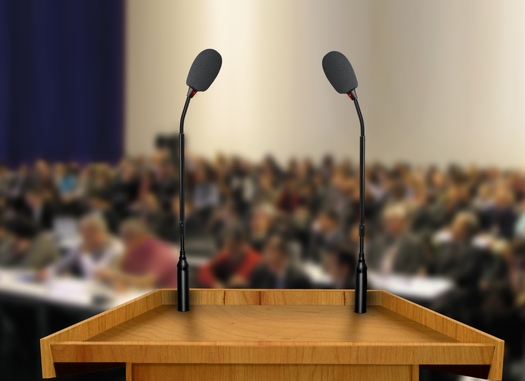
3 Things to think about when Filming a Conference Video
Video is the ideal medium for showcasing speakers and presentations to people who could not attend your Conference. Video can also be used to market your next conference to prospective attendees. No matter why your conference is being filmed, here are three things which you should consider.
1. Location and Surroundings For Conference Videos
The location is one of the most important thing to think about when filming a conference video, because this will give the all important ‘first impression’ of the conference. When filming speakers the background should be non-descript but still attractive and professional. This ensures the audiences attention is focused on the speakers content without appearing too dull. A background that is completely plain – white for example – is likely to cause viewers to lose interest. This changes when filming attendees of the conference, stands or performances. In this case they would be better suited to a plain or branded background. These setups are often busy or brightly coloured and will already be sufficiently attention grabbing.
Remember the importance of natural lighting when choosing a location. When conferences are held during the day it means you do not have to spend as much time lighting speakers. This gets more difficult when you are in a darkened room or theatre space, where you will probably have to work with stage lighting staff to tell them what you would like. Speak to the venue owner where you will be filming in and get some stills of the location so that the production crew can make an assessment of the space.
2. Multi Camera Set Ups For Conference Videos
Typically you want a minimum of a two camera set-up for conferences. This allows you to capture speakers from more than one angle and alternate to audience reactions.
The benefits of using only two cameras are:
- You can have one camera fixed on a speaker and allow one to move
- Allows for a varied and interesting final edit
- Footage of speakers can be edited together seamlessly with audience reactions
- You can create the illusion of having many more cameras on your shoot by moving the camera during the conference
The disadvantages include:
- Running and managing two cameras can be more costly than one
- Less variety of footage can be captured than with a larger number of cameras
In contrast to this a three camera shoot can really boost the production value of your video and give it a professional edge.
The advantages of a three camera shoot include:
- Allows for two fixed camera angles, for example a shot of a speaker and a shot of the audience, whilst leaving one camera free for creative movement shots
- There is ability to create a better variety of footage and scope for highlighting different elements of the conference which may have otherwise been missed
- This is best used to capture full length speech videos that require slick edit intended for a wide audience
- The finish is well put together and professional
The disadvantages of this are:
- More costly to produce, you may have to hire cameras/external camera operators
- Requires greater planning to determine how three angles can be used to be your best advantage
- It can make your camera crew more noticeable, meaning that there may be interruptions with guests asking what you are doing, or security clearances
3. Capturing Speakers Content
Speaker’s multimedia presentations can present challenges to film. Often projections do not show up well when being recorded on camera. This may leave you with footage that is shaky or cannot be viewed. To avoid this issue contact the speakers and ask for a copy of the presentation. These can either accompany the video or be edited directly in with speech on top, providing the video audience with the same experience that the attendees received.



